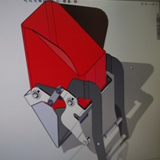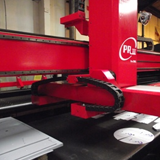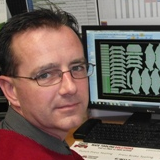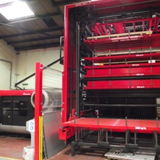



Remnants and Part Picking Vital For Europe’s Finest
Remnant and part picking capabilities of the world’s most powerful sheet metal CAD/CAM software, RADAN, play a vital role in helping an engineering subcontractor get maximum efficiency from their CNC machines.
Recol Engineering are regarded as one of the most respected sheet metal fabrication companies in Europe, producing high quality, precision sheet metalwork in stainless and mild steel, and aluminium, largely for the food distribution industry. One of their main production lines is for stainless steel hoppers (pictured right) that measure food quantities for packing.
Their Amada F1 laser and the market-leading Amada EML 3510 NT with full automation, high speed servo-electric punch with combined 4 kw laser are both driven by RADAN, from the Vero Software stable, and both have racking towers.
Recol’s head of Engineering Simon Hollin says part picking (pictured left) on the EML is an essential part of their production process. “But we had major issues regarding part picking with our previous software...it just wouldn’t do what we wanted it to, which is why we switched to RADAN.”
Recol worked closely with RADAN to ensure the software would handle their specific part picking requirements.
Now, when they have nests with large, similar parts, the EML combination laser-punch cuts the part three-quarters of the way out; then arms sucker the part for its final cut before it is stacked in a predetermined position on a bed. When the machine has completed all the part picks the skeleton is taken off and stacked at the back of the machine if it is scrap, or at the front if it can be used as a remnant.
“We can create as many as 50 nests and just leave the machine running overnight. It all helps us to achieve optimum production.”
And RADAN’s renowned capability for handling remnants also ensures that material wastage is kept to a minimum, having a positive impact on the company’s bottom line. “We have a number of nests that don’t use the whole sheet. Where we have a remnant it’s transferred into an ‘Unreleased’ folder. Once we’ve run the nest that’s been produced from it it’s transferred into our ‘Remnants’ folder. When we create another nest, RADAN scans for remnants first, and puts as many parts as it can on those remnants before going on to use full sheets. This is done automatically and means we don’t have to buy as much raw material.”
While sheet utilisation is an important requirement to keep costs down, Recol’s I.T. Manager Ben Guntrip says there are so many variables involved in nesting that they take a number of other aspects into consideration to keep the production line running smoothly. “It’s acceptable to waste a certain amount of sheet space to save time on the shop floor. We focus heavily on organising nests into certain formats. We tweak our nests to create a sheet that may contain three different segregated areas of the same part. Otherwise, the system would nest dissimilar products all over the sheet, meaning that we’d then have to spend time working out from a small printout where each product is.
“For instance, instead of having small brackets spread all over the sheet, we’d rather sacrifice a bit of sheet space and have them in rows, which will save us time. Sheet utilisation is important, but it’s not always the best overall solution, so we make full use of the option to manually adjust the nest once RADAN has created it automatically.”
Three of Recol’s five engineers who use RADAN are virtually full time programmers on it. Each engineer decides which machine they create a nest for, depending on the requirements of the individual job. For example, components for an electronic digital display stand are produced mainly by punching, and are manufactured for various locations throughout the world, whereas the food hopper components need a perfect cut, so the outside profiles are always lasered.
With RADAN being an industry-standard software, Ben Guntrip expects candidates applying for jobs at the Northamptonshire-based company to be able to use it. “It’s one of the main prerequisites we ask engineers.”
However, Simon Hollin says because RADAN is so easy to learn, engineers can be reasonably adept at using it within a week, even if their initial knowledge of it is limited. “It’s extremely intuitive – from a drawing engineer’s point of view it’s the simplest, yet the most powerful, system to use.”






